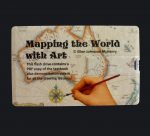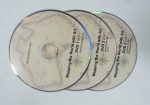Mapping the World with Art VIDEO E-COURSE (This includes a digital copy of the text)
$32.95
This is a VIDEO e-course, not a book.
This is exactly the same product as the other “Mapping the World with Art” products, just in a format that lets you stream the videos instead of purchasing the DVDs. You access the course through the eSTORE each time you want to do a lesson. Go to the STORE, then click on MY COURSES. This video ecourse also gives you a digital download version of the book, so you DON’T need to purchase that download separately.
No special artistic skill or previous knowledge is required for the drawing lessons.
- Description
Description
HOW TO ACCESS THIS COURSE AFTER YOU PURCHASE IT: Go to the estore and click on MY COURSES. This course should be listed. Click on it and the lessons should appear. (Make sure you are logged in using the same email that you used to purchase the course.)
NOTE TO HOMESCHOOL GROUPS: If you are planning on using this course with a group during the coming year, and you are concerned about in-person classes being cancelled and having to find a way to work online, please write to me and ask about a discount coupon for the families in your group, so they can all have access to the curriculum at home should the need arise.
******************************************************
VIDEO REVIEW of this curriculum: https://youtu.be/dq5pXZ-FeR4
Target age group: 10-16 (history text and drawing lessons are appropriate for over 16, or even adult learners)
Structure of curriculum: This curriculum is in 3 parts:
Part 1 contains 30 short history lessons. Each lesson is one double-sided page. The writing is straightforward and easy to understand and is accessible to younger students, but it does not have a patronizing “written for kids” tone, and thus is appropriate reading for older students as well. The drawing lessons and activities are based on the themes of the history lessons. The lessons start with the beginnings of cartography in ancient Greece, and end with the official discovery of Antarctica in the 1800s.
Part 2 contains the drawing lessons. Each drawing lesson has step-by-step pictures that guide the student as they draw an area of the world from scratch (starting with nothing but a blank piece of paper). This method of learning is absolutely ideal for kinetic learners, but I have found it extremely effective for all types of learners. (I found it so effective that after writing “Mapping the World” I now use at least one “draw-from-scratch” activity in every subject I teach.) The drawing lessons progress in such a way that later drawings incorporate earlier ones. For example, in one of the first lessons you learn to draw the Nile River. Later, when you draw Africa, you already know how to draw the Nile. The drawing lessons tend to stay away from political boundaries, although some could not be avoided (France and Spain, for example).
Part 3 contains extra activities and worksheets that go with the history lessons and/or the drawing lessons. Activities include extra worksheets for practicing what was learned in the drawing lessons, group games, board games, crafts such as making simple navigational instruments, or art projects (about maps) using paint, crayons or colored pencils. There are also many supplemental videos suggested, all of which can be accessed for free via the Internet. The videos are mostly documentaries about the navigators who sailed around the world, or brief video visits to the places the students have drawn.
VIDEOS: If you or your student has trouble following step-by-step pictures. you can watch the video of the lessons to get the general idea of how to do the drawing. Please don’t rely on just the video demonstrations, however. Have the printed versions of the lessons near at hand so you can refer to them for sharper images of sketch lines and labels.
Time needed to complete the curriculum: Personally, I would use this curriculum over the course of the entire year, using one chapter per week. I’d do the history lesson and drawing one day, and one or more of the activities on another day of that same week. However, you may use this curriculum however you want to. You may have a student who wants to zip through the drawings at a fast pace. That’s fine. Do whatever works for you.
NOTE: If you are in Classical Conversations, please see the note at the bottom of the FAQ’s.
***************************************
Table of Contents:
(Lessons 2, 13, 15, and 27A are available (free) for you to preview. Click on the links.)
1: Mesopotamia
3: Greece
4: The Roman Boot
5A: The “Holy Land:
5B: The Arabian peninsula
6A: The Black Sea
6B: The Caspian Sea
6C: The Aral Sea
7: The Iberian Peninsula
8A: France
8B: Adding France to the Iberian Peninsula
9: India
10: The Greater Antilles
11: The Lesser Antilles
12A: Britain
12B: Newfoundland
14: Central America and the Caribbean
16: Southeast Asia and Malay peninsula
17: Indonesia and the Spice Islands
18A: The Strait of Magellan
18B: The Philippines
19: The eastern coast of North America
20: Gulf of St. Lawrence and Labrador
21: The west coast of America
22: Scandinavia
23A: The Low Countries
23B: Ireland
23C: Iceland
24: Greenland, Hudson Bay and Baffin Island
25: Japan
26A: Australia
26B: New Zealand
27B: Kamchatka peninsula
28A: Top of North America, two projections
28B: Top of Asia
29a;29G: Islands of Pacific
30: Antarctica
******************************************
FAQs:
— How much would it cost to print out the book using my own printer? Printing out the entire book can be a bit pricey, as there are so many color pages. If you own a laser printer, you can probably print out a copy of the entire book for about 3 cents a page, which would be a total of around $10-12 US dollars. Copy shops may charge as much as $30 USD to print the book. And that’s not including binding. You might find that it is actually cheaper to order the paperback version on Amazon.com or BookDepository.com.
— Can I use this curriculum in conjunction with another? Yes, the history lessons are brief, so it would not be too much for your student(s) to read other history lessons alongside these. A book that dovetails particularly well is “Around the World in 100 Years” by Jean Fritz.
— Can I just use bits and pieces of this curriculum without using the whole thing? You can use as much or as little of it as you want to. Just pick and choose what you want to use. Some people just choose the drawing lessons that are helpful at certain points in their own curriculum. (However, please note that some of the later drawings lessons do use bits and pieces from earlier ones.
— Can I use this with multiple age groups? Yes. In fact, this curriculum is ideal for using with mixed ages. I’ve heard back from customers who have used this curriculum with students as young as 7 or 8 (although I really don’t recommend it for kids this young) and as old as 18.
— Can I use this curriculum with a group? Yes, it is great for using with a group. Even if you have no art skills at all, you can offer your group a geography drawing class. Just pop the DVDs into a DVD player and have the group watch the drawing lessons. This is especially helpful if your group has a very small budget and can’t require that each family purchase the curriculum themselves.
— Can I get extra copies of the curriculum on CD to give to students in a group? Yes, just contact me about bulk discounts.
— Can I get a replacement DVD if I lost one? Yes, just contact me by email.
— Is the similarity of your title to “Mapping the World by Heart” intentional? Somewhat. My curriculum was born out of my frustration and sense of disappointment with that curriculum. I determined I could do better. I knew that it was likely that many people had experienced what I had– thinking the curriculum was going to provide real instruction and finding it did not. I had already signed up for a whole year of teaching art and geography to a large group of kids, so I had no choice but to write my own materials week by week. That’s how the book came about.
— Can I fit this in somehow with Classical Conversations Challenge A?
Mapping the World through Art is BEST used as a precursor to Challenge A. It breaks down the process of drawing the world’s coastlines and makes it seem like a manageable task. I used this book the year before we did Challenge A and it was a big help.
The order, pace and priorities are very different, though. Mapping the World through Art puts a lot of emphasis on getting proportions right, whereas the most successful memorizers in CC were the ones whose Florida still looked like a lollipop stick, and whose United States was disproportionately large (which allows for labeling more features) compared to their tiny Asia. (They put very little emphasis on the features, if you want to know where to cut back on the work. Assuming your tutor is working with the same philosophy that my child’s tutor was, there were some things she drilled in class through fun games… other details were up to the discretion of the family and many chose to shorten the memorization lists.)
You will find that Mapping the World through Art will give you successful quick strategies for drawing Central America (particularly the islands, which are challenging) and South America. It will not help you much at all when drawing Canada and the US, since it does not address any geopolitical boundaries.
In the spring you will find that it will be a little hard to find the instructions for the coastline of Europe and Asia, since they are done in order of historical importance for the purpose of Mapping the World through Art. I love the idea of walking through history while drawing the world (and we remembered so many interesting facts because of our time using MTWTA), but this is not the order of memorization and drawing in ChA. If you have time to develop your skills, you would certainly be able to figure it out, but it won’t be quick work. Africa, on the other hand, would be easy enough to find and draw from Mapping the World through Art, although again none of these continents will be presented with country boundaries. You will find many new strategies for drawing as you work, and Europe and Asia won’t scare you as much then as they do now. (Also you will get 5 weeks on each one, so the most important idea to focus on for those continents is time management.)
No matter how you choose to do it, the important thing to remember for the purpose of Challenge A geography is that you must get to the blank sheet of paper quickly. Our best weapons for last year were repetitive tracing, and paper folding that broke the paper into chunks. My son did find that South America and Central America were very easy for him because of his prior knowledge of how to draw the shapes (as I mentioned we had done some of the lessons from Mapping the World through Art the previous year). Africa was also easier for him, I think, for the same reason.



